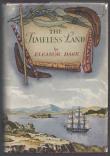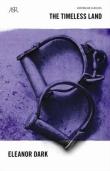AustLit
 5119176707943851635.jpg
5119176707943851635.jpg
Latest Issues
AbstractHistoryArchive Description
'The year 1788: the very beginning of European settlement. These were times of hardship, cruelty and danger. Above all, they were times of conflict between the Aborigines and the white settlers.
'Eleanor Dark brings alive those bitter years with moments of tenderness and conciliation amid the brutality and hostility. The cast of characters includes figures historical and fictional, black and white, convict and settler. All the while, beneath the veneer of British civilisation, lies the baffling presence of Australia, the 'timeless land'.
'The Storm of Time and No Barrier complete the Timeless Land trilogy. ' (Publication summary)
Notes
-
Dedication: For my son Michael Dark.
Publication Details of Only Known VersionEarliest 2 Known Versions of
Other Formats
- Braille.
- Sound recording.
Works about this Work
-
Writing Bennelong : The Cultural Impact of Early Australian Biofictions
2020
single work
criticism
— Appears in: The Journal of Commonwealth Literature , September vol. 55 no. 3 2020; (p. 433–448)'In 1941 Ernestine Hill published My Love Must Wait, a biographical novel based on the life of navigator Matthew Flinders. In the same year, Eleanor Dark published The Timeless Land, imagining the arrival of European settlers in the Sydney region from the perspectives of multiple historical figures. In this article we examine how each author represents the important figure of Bennelong, a man of the Wangal people who was kidnapped by Governor Phillip and who later travelled to England with him. While both works can be criticized as essentialist, paternalist or racist, there are significant differences in the ways each author portrays him. We argue that Dark’s decision to narrate some of her novel from the point of view of Bennelong and other Indigenous people enabled different understandings of Australian history for both historians and fiction writers. Dark’s “imaginative leap”, as critic Tom Griffiths has termed it, catalysed a new way of thinking about the 1788 invasion and early decades of the colonization of Australia. The unfinished cultural work undertaken by these novels continues today, as demonstrated by subsequent Australian novels which revisit encounters between Indigenous inhabitants and European colonists, including Thomas Keneally’s The Chant of Jimmie Blacksmith (1972), Richard Flanagan’s Wanting (2008), and Rohan Wilson’s The Roving Party (2011). Like Dark, these authors situate parts of their novels within the consciousness of Indigenous figures from the historical record. We analyse the diverse challenges and possibilities presented by these literary heirs of Eleanor Dark.' (Publication abstract)
-
A Makarrata Declaration : A Declaration of Our Country
2017
single work
essay
— Appears in: The Best Australian Essays 2017 2017; (p. 41-50)'Salman Rushdie — the great Indian writer — once said of the importance of stories: 'Those that do not have the power over the story that dominates their lives, the power to re-tell it, re-think it, deconstruct it, joke about it, and change it as times change, truly are powerless because they cannot think new thoughts.' ' (41)
-
‘This Long and Shining Finger of the Sea Itself’ : Sydney Harbour and Regional Cosmopolitanism in Eleanor Dark’s Waterway
2017
single work
criticism
— Appears in: JASAL , vol. 17 no. 1 2017;'In Eleanor Dark’s novel Waterway (1938), Professor Channon is prompted by the ominous international headline ‘Failure of Peace Talks’ to imagine the world from a global perspective (120). Channon feels himself metaphorically ‘lifted away from the earth … seeing it from an incredible distance, and with an incredible, an all-embracing comprehension’ (119-20). This move outward from a located perspective to ‘a more detached overview of a wider global space’ signifies a cosmopolitan viewpoint, ‘in which the viewing subject rises above the placebound attachments of the nation-state to take the measure of the world as a wider totality’ (Hegglund 8-9). Yet even this global view is mediated by Channon’s position from within ‘a great island continent alone in its south sea’ (121). Gazing from a ‘vast distance,’ he views Europe as ‘the patches where parasitic man had lived longest and most densely,’ and from which humankind ‘went out to infect fresh lands’ (120). This description of old world Europe as ‘parasitic’ provides a glimpse of resistant nationalism, reflecting Channon’s location within one of the ‘fresh lands’ affected by colonisation. Channon is ultimately unable to sustain a ‘Godlike’ perspective in this scene, desiring ‘nothing but to return’ to local place (121). Although his view initially ‘vaults beyond the bounds of national affiliation’ (Alexander and Moran 4), this move outward does not ‘nullify an affective attachment to the more grounded locations of human attachment’ (Hegglund 20). Channon’s return to the ‘shabby home … of his own humanity’ brings a renewed sense of connection to ‘the sun-warmed rail of the gate’ and ‘the faint breeze [which] ruffled the hair back from his forehead’ (122).' (Introduction)
-
Indigenous Lives, The ‘Cult of Forgetfulness’ and the Australian Dictionary of Biography
2017
single work
essay
— Appears in: The Conversation , 1 November 2017;'In 1968 the esteemed Australian anthropologist Bill Stanner coined the term “the great Australian silence” to describe a “cult of forgetfulness” that had seen Aboriginal people virtually ignored in the writing of Australian history. The Australian Dictionary of Biography had published its first two volumes by then, and the indifference that Stanner observed was already apparent in its choice of biographical subjects.
'The architects of the dictionary had envisaged a great national co-operative venture with autonomous working parties in each state whose members would choose “significant and representative” subjects, a “cross-section of Australian society”. In succinct articles, these lives would collectively illustrate the Australian national story.'
-
Modernist Fiction/Alternative Modernisms : Australia, Canada, New Zealand
2017
single work
criticism
— Appears in: The Oxford History of the Novel in English : The Novel in Australia, Canada, New Zealand, and the South Pacific Since 1950 2017; (p. 190-204)'What is it about modernism, that multivalent category riven with internal contradictions, that makes literary criticism continue to value it as a category?...' (Introduction)
-
Out of Australia
1941
single work
review
— Appears in: The Nation , 4 October vol. 153 no. 14 1941; (p. 316)
— Review of The Timeless Land 1941 single work novel -
As It Was Then
1964
single work
review
— Appears in: Southerly , vol. 24 no. 1 1964; (p. 68-69)
— Review of No Barrier 1953 single work novel ; The Timeless Land 1941 single work novel ; Storm of Time 1948 single work novel -
Redemption
1941
single work
review
— Appears in: The Times Literary Supplement , 1 November no. 2074 1941; (p. 541)
— Review of The Timeless Land 1941 single work novel -
Untitled
1941
single work
review
— Appears in: New York Herald Tribune , 5 October 1941;
— Review of The Timeless Land 1941 single work novel -
Untitled
1941
single work
review
— Appears in: The New York Times Book Review , 5 October 1941;
— Review of The Timeless Land 1941 single work novel -
Story for Our Times
2006
single work
correspondence
— Appears in: The Courier-Mail , 26 January 2006; (p. 24) -
'Book News' Arranges for Exhibit
1947
single work
column
— Appears in: The Australasian Book News and Library Journal , April vol. 1 no. 10 1947; (p. 443) Book News persuades the Department of Post War Reconstruction to include Australian literature in the Australian section of the British Empire Exhibition at the Royal Easter Show. Book News calls once more for a National Book League. -
Can You Better This Book List?
1945
single work
column
— Appears in: Book News , August no. [1] 1945; (p. 3) -
y
 Understanding the Novel: The Timeless Land
Brisbane
:
Jacaranda Press
,
1966
Z23192
1966
single work
criticism
Understanding the Novel: The Timeless Land
Brisbane
:
Jacaranda Press
,
1966
Z23192
1966
single work
criticism
-
The Progress of Eleanor Dark
1951
single work
criticism
biography
— Appears in: Southerly , vol. 12 no. 3 1951; (p. 139-148)
- Sydney, New South Wales,
- 1780s








